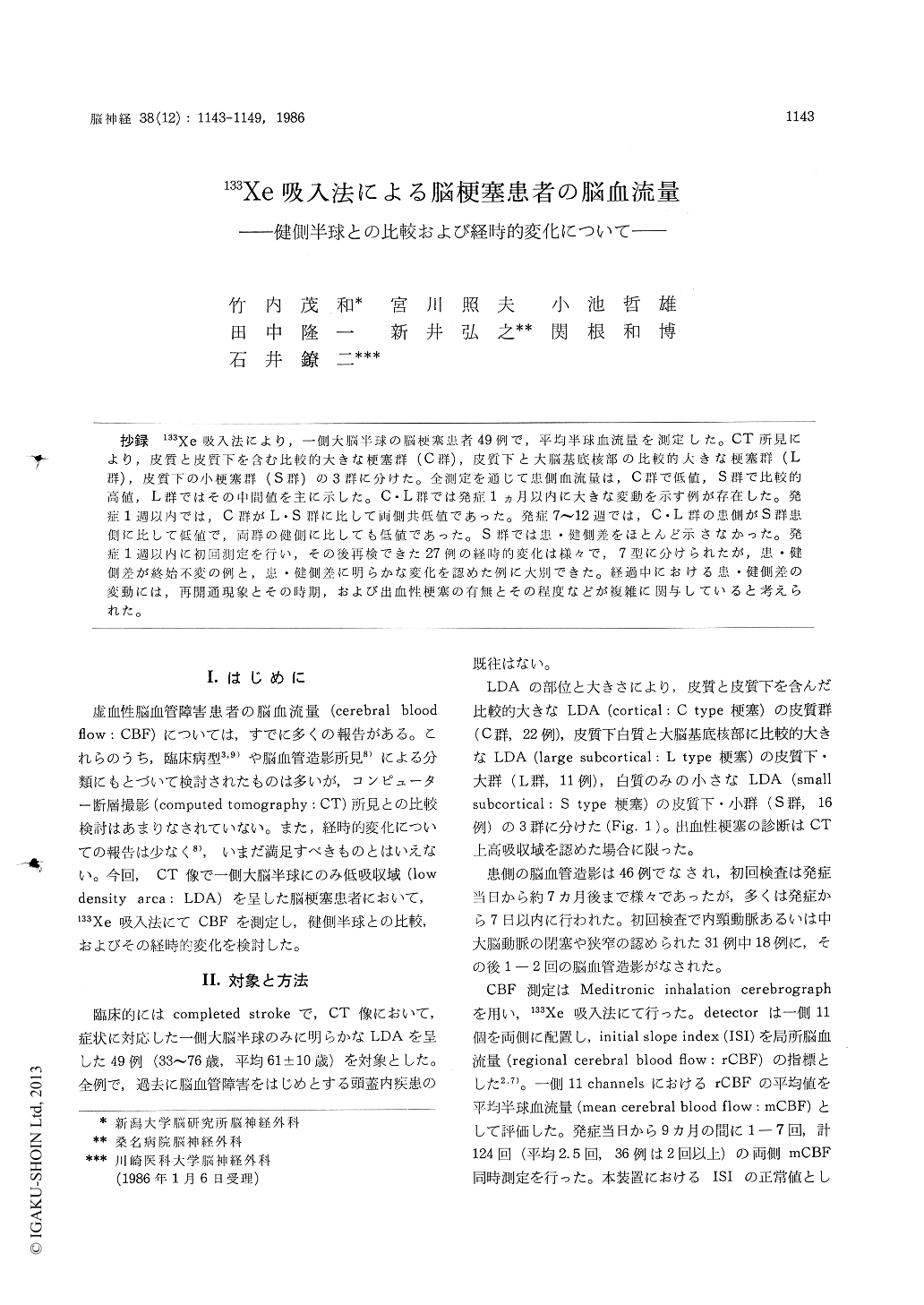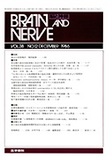Japanese
English
- 有料閲覧
- Abstract 文献概要
- 1ページ目 Look Inside
抄録 133Xe吸入法により,一側大脳半球の脳梗塞患者49例で,平均半球血流量を測定した。CT所見により,皮質と皮質下を含む比較的大きな梗塞群(C群),皮質下と大脳基底核部の比較的大きな梗塞群(L群),皮質下の小梗塞群(S群)の3群に分けた。全測定を通じて患側血流童は,C群で低値, S群で比較的高値,L群ではその中間値を主に示した。C・L群では発症1ヵ月以内に大きな変動を示す例が存在した。発症1週以内では,C群がL・S群に比して両側共低値であった。発症7〜12週では,C・L群の患側がS群患側に比して低値で,両群の健側に比しても低値であった。S群では患・健側差をほとんど示さなかった。発症1週以内に初回測定を行い,その後再検できた27例の経時的変化は様々で,7型に分けられたが,患・健側差が終始不変の例と,患・健側差に明らかな変化を認めた例に大別できた。経過中における患・健側差の変動には,再開通現象とその時期,および出血性梗塞の有無とその程度などが複雑に関与していると考えられた。
Cerebral blood flow in both hemispheres was studied by the 133Xe inhalation method in 49 pa-tients with cerebral infarction in the unilateral hemisphere. They were classified into three groups by computed tomographic findings as follows ; relatively large low density lesion in-cluding the cerebral cortex and subcortex (cortical : C group), relatively large low density lesion in-cluding the subcortical white matter and basal ganglia (large subcortical : L group), and small low density lesion including the subcortical white matter (small subcortical : S group), respectively. Mean cerebral blood flow (mCBF) in the affected hemispheres was markedly low in C group, mo-derately low in L group, and slightly low in S group, in all of the examinations. Several cases in C and L groups revealed remarkable changes of mCBF less than one month after the onset. MCBF in both hemispheres was lower in C group than in L and S groups less than one week after the onset. Seven to twelve weeks after the onset, mCBF in the affected hemisphere was lower in C and L groups than in S group, and than in the unaffected hemisphere of C and L groups. There was no difference between mCBF in the affected hemisphere and that in the unaffected hemisphere in most of S group. Sequential changes of mCBF in both hemispheres were di-vided into seven types in 27 cases, who were examined first less than one week and repeatedly then. However, the sequential changes were clas-sified roughly into two patterns. The one pattern revealed the course with stable difference between mCBF in both hemispheres, and the other did that with remarkable changes of difference between mCBF in both hemispheres. MCBF in the affected hemisphere showed a higher value than in the unaffected hemisphere in one examination of three cases of C group and one case of L group, and an almost similar value to that in the unaffected hemisphere in an initial examination of two cases of C group and one case of L group. In these seven cases, recanalization of an occluded site was observed. In five cases out of seven, there was hemorrhagic infarction. In other two cases of L group, mCBF of the affected hemi-sphere first was a definitely lower value than that of the unaffected hemisphere, and then it was increased with time to be an almost same value as that of the unaffected hemisphere. Recanaliza-tion was found without hemorrhagic infarction in these two cases. Sequential changes of mCBF in both hemispheres of the patients with cerebral infarction were considered to be caused mainly by recanalization and hemorrhagic infarction.

Copyright © 1986, Igaku-Shoin Ltd. All rights reserved.


